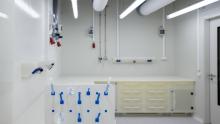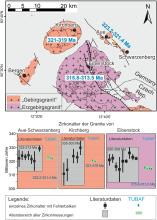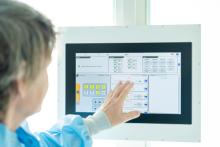TU Bergakademie Freiberg already has a cleanroom laboratory for the field of applied physics - now, a second one is being added. However, the new cleanroom laboratory at the Institute of Mineralogy has a special feature: it is metal-free. This means that the furnishings and equipment are made entirely of non-metallic material, with the necessary metal parts encased in synthetic substances. If thery were exposed to metal in the room, the highly sensitive analyses for dating rocks would be falsified.
Professor Marion Tichomirowa and her team are the first to move into the laboratory. Together with Junior Professor Maximilian Lau, Professor Johannes Heitmann and representatives of the university's administration (Ingolf Köhler, Eric Dalke), the mineralogist opened the new metal-free clean room laboratory at TUBAF on 16 April.
The researchers can determine the geological age of rocks very precisely in the metal-free clean room using what is known as uranium-lead dating. Prof Marion Tichomirova heads the university's existing isotope laboratory and was instrumental in initiating and implementing the construction of the new metal-free clean room in the Clemens Winkler Building. "The Freiberg isotope laboratory at the Institute of Mineralogy is the only laboratory in Germany to carry out high-precision dating of rocks. Compared to other dating methods, we can determine the age of rocks ten times more accurately with this method," explains Professor Tichomirova. This makes uranium-lead dating the most precise "geological clock" currently available to researchers.
Important conclusions for the Earth's history
For example, when it comes to determining the exact sequence of various geological events that occurred in close succession, researchers rely on uranium-lead dating. "Take the extinction of the dinosaurs: it was long disputed whether a meteorite impact around 66 million years ago or strong volcanic activity led to the extinction of the dinosaurs. The high-precision dating method was able to show that both events contributed to the extinction."
Another example is the formation of ore in the Ore Mountains. The uranium-lead dating from the Freiberg isotope laboratory has already provided new insights into this: "We were able to show that the neighbouring large granite bodies of the Westerzgebirge are not the same age as assumed. On the contrary, the granites of Aue-Schwarzenberg formed first (around 323 - 321 million years ago), after which the Kirchberg granite intruded around two million years later (321 to 319 million years ago). Another five million years later (316 to 314 million years ago), the magma of the Eibenstock granite solidified," Prof Marion Tichomirowa explains.
Metal-free cleanroom ensures less lead and more precise analyses
The new cleanroom laboratory in the Clemens-Winkler Building is one of the few metal-free laboratories in the world. As all metals contain lead, the dating method can be falsified by "lead contamination" even in a non-metal-free cleanroom laboratory: "The quantities of lead produced by radioactive decay in the analysed mineral zircon are extremely small; they are around 50 picograms, or 0.00000000005 grams. The amount of lead that is added in the laboratory during the analytical steps should therefore be at least 50 to 100 times smaller. Only in a metal-free clean room is it possible to achieve such low "blank values" for lead."
In the new laboratory, the researchers can now also analyse smaller and younger zircons and determine the age of these rocks even more precisely than before. In the field of geosciences, TU Bergakademie Freiberg now has a unique clean room that enables cutting-edge research. There are only around 10 to 15 other metal-free clean room laboratories in the world. The Free State of Saxony is covering the costs of around 2 million euros for setting up the laboratory.
Research groups at TU Bergakademie Freiberg who would like to use the laboratory should contact Prof Marion Tichomirowa by email.


